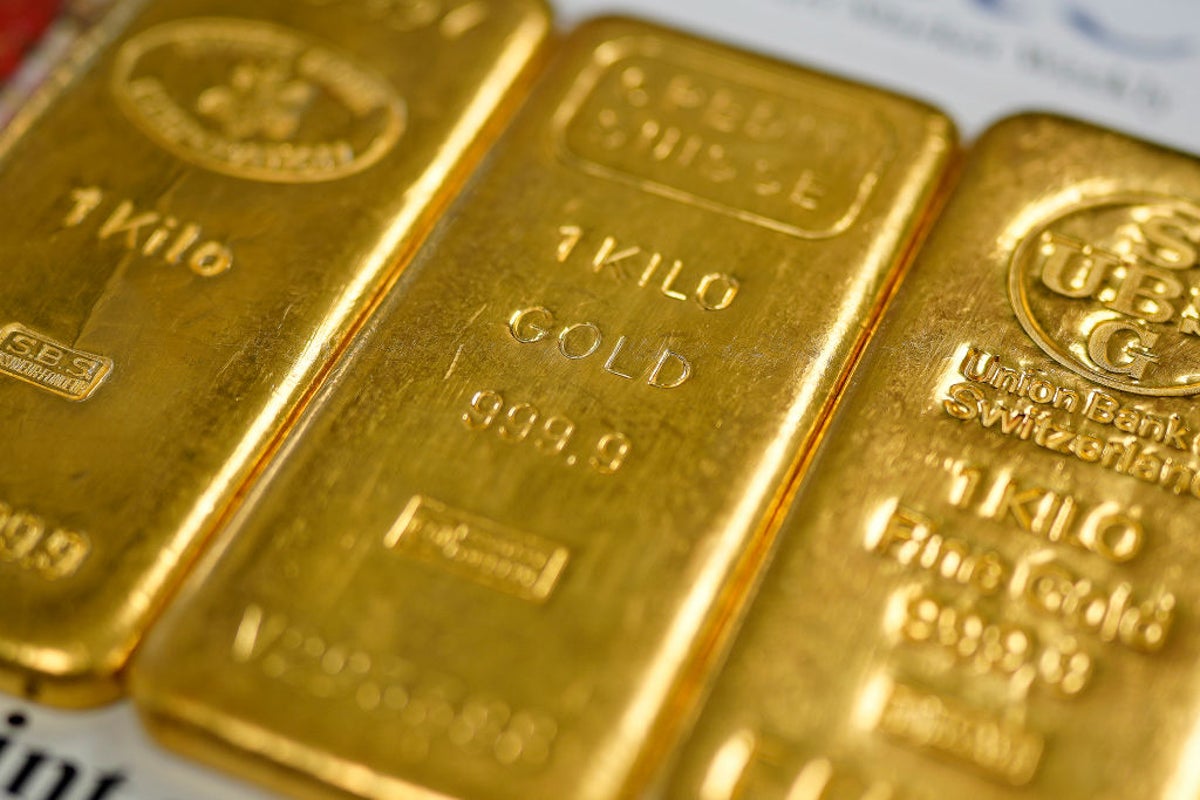Donald Trump – yes, him again – has sparked a surge in gold prices with the commodity hitting record highs after the White House unexpectedly announced new tariffs on 100-kilo and 100-ounce bars this week.
The precious metal – a traditional safe haven during troubled times – is trading for north of $3,500 an ounce. How long before it breaches the $4,000 barrier? Those intending to buy jewellery, take note.
America’s decision to hit imports of gold bars from Switzerland, a major refining centre, with tariffs was not what the industry expected and has poured rocket fuel onto an already frothy price. The Financial Times reports that Switzerland sent $61.5bn (£45.8bn) of gold to the US over the 12 months ending in June. That would be subject to a $24bn charge under the new 39 per cent tariff applying to imports from the country.
The gold price was already running hot. It is a traditional port in a storm during periods of economic and political turmoil, both on the markets and across the world as a whole. Globally, the stakes are high, with geopolitical brush fires smouldering dangerously close to full-blown crises.
It is also used as a hedge against inflation. With a limited supply, the price should rise if inflation starts to eat into the value of the currencies in which it is priced, especially the dollar. With US tariffs now at their highest level since the great depression, inflation is about to dig its fangs into the US economy and feast on the living standards of the US consumer.
As well as imposing tariffs, Trump has been pressing the US Federal Reserve to reduce the interest rates that control inflation. While its embattled chair Jerome Powell has (so far) refused to budge, saying he needs time to evaluate the impact of the tariffs, the early departure of Adriana Kugler from its board of governors has given the president an opening. Trump has announced that he will appoint Stephen Miran to temporarily fill the vacant seat, seen by some as a candidate for Powell’s position when his term ends next year.
Miran, a Harvard economist and adviser to the US Treasury, is one of the architects of its tariff policy and has pooh-poohed critics like me who have warned that the levies will inevitably stoke inflation. The appointment will give him a vote on the rate-setting Federal Open Market Committee (FOMC), where he is widely expected to toe the Trump line. If this leads to lower US rates, and even higher inflation, it will make gold even more attractive.
The tariff on Switzerland’s gold bars has injected an extra cost into the market because the country is part of a three-pronged golden triangle, the others being New York and London, where the metal is traded. Its role is to recast the bars, from the brick-side 400-troy-ounce bar favoured in London to the smaller, smartphone-sized kilo size favoured in New York. Yes, I know. The UK is part-metric, whereas the US is all imperial in terms of measurements. But whoever said any of this was supposed to make sense?
As recently as 2004, with the rest of the City using screens, the gold price was still being “fixed” in the offices of NM Rothschild, an old school merchant bank, on St Swithin’s Lane, London. As part of the process, each of the market makers involved had a desk with a phone and a miniature flag. These were raised when they wanted to pause the process to take soundings, and lowered when they were ready to fix.
The proceedings were conducted in conditions of high secrecy – no outsider (so far as I know) was ever allowed to watch. However, I was once lucky enough to be allowed a rare visit to the rather underwhelming but still quaint room in which the fix took place. The process was modernised, becoming phone-based (in line with other precious metal fixes) when NM Rothschild pulled out. But participants still call “flag” when they wish to pause. Cute.
These days, the London Bullion Market Association prefers to call the fix a “benchmark”, not least because it became clear that the process was being fixed in the negative sense of the word, along with several other of the City’s benchmark prices, in the string of scandals that followed the 2008 global financial crisis.
Barclays ultimately ended up getting hit with a £26m penalty “for failing to adequately manage conflicts of interest between itself and its customers as well as systems and controls failings, in relation to the gold fixing”. But the twice-daily event persists because, even though the spot price of gold moves up and down through the day, market participants find it useful.
What is Trump’s rationale for gold tariffs? The conspiratorial part of me briefly wondered whether this was part of a cunning plan to muck up the international market and push people towards Bitcoin, which the president is a notable enthusiast for. Bitcoin can play a similar role to gold in hedging against inflation because there is also a limited supply and it is priced in dollars.
But no, it really isn’t that deep. For a start, the Bitcoin market scarcely needs any help. The cryptocurrency has more than quadrupled in value over the past three years, while gold has almost doubled. Inflation will keep both commodities hot.
Just as likely, given the way these tariffs have been concocted, is that someone in the US government choked on some fondue or a piece of gruyère cheese, and acted in a fit of pique.
Together, this archaic corner of the City and Trump’s capriciousness have served up something bleakly comic, unless that is, you’re planning to buy gold jewellery for an engagement or a wedding or perhaps, because you just like wearing it. Then it’s not funny at all.
Will Trump pay a price at the polls? He seems determined to give his opponents a golden opportunity they really don’t deserve.
